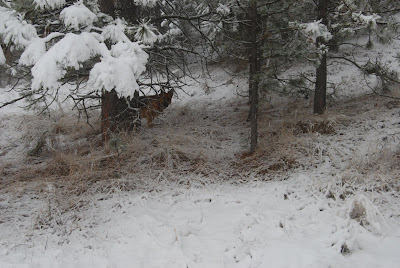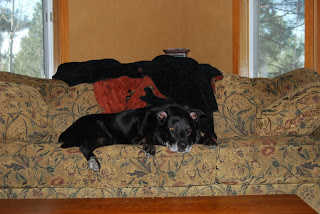What if your beloved lab mix, "Shadow," got out of the yard one day and went on walkabout? What if instead of a good Samaritan, someone picked him up and took him off to a place where eating dogs was considered normal (such places do exist)? What if someone pulled out all of Shadow's teeth without anesthetic (too costly) to keep him from biting, and stuffed him into a small cage, in a room full of cages filled with the smells of urine, feces, and fear, where the wire cut his feet until they became infected? When he howled in loneliness and pain, wondering perhaps, what he'd done to deserve such treatment, what if someone shoved an electric prod through the cage to shut him up? After this and more, followed by a brutal slaughter, what if he ended up on your dinner plate, in a can of Dinty Moore Stew?
The story above sounds far-fetched only because we live with dogs named Shadow, and Buddy, and Lucky, and Nicholai. We know them, see in their eyes fear and friendliness, and know from their wiggling butts and thumping tails, excitement, anticipation, and welcome. We love them and we don't think of them as food. Because of their proximity, we have not forgotten who they are.
I live with chickens in my backyard. They're colorful and curious; they have preferences and clear delights – corn on the cob, Caesar salad, wild bird seed. When our hen, Hazel, was broody – sitting for weeks on eggs that refused to hatch – we purchased six baby chicks from a local feed store, seduced Hazel off her nest with wild bird seed, and replaced the tired unfertile eggs with the fluffy chicks. Hearing tiny peeps from the nesting box, Hazel poked her head in. She snapped her head back, chicken fashion, tilting from one side to the other, then peered back in, already clucking softly. Then slow and cautious, she stepped into the nest and took the babies under her wings. For weeks she was mother hen to these orphans, preening and protecting. We heard a particular vocalization we termed her "good food cluck," that she used to draw the chicks' attention to particularly delectable tidbits. Clearly, Hazel had communication with and compassion for the chicks in her charge. Several years later, when the baby chicks were grown, Hazel was taken by a raccoon in the early morning hours. We heard a vocalization we had never heard from any of our hens or roosters before; a long, loud cry – a caaawww– as the baby-chicks-turned-hens appeared to announce, and maybe even to mourn, the disappearance of their momma.
Once, we knew chickens, today we have all but totally forgotten.
All chicken meat and chicken products – including dog food – purchased at supermarkets comes from factory farmed chickens. Engineered for grotesque breast development, the Cornish-cross birds quickly outgrow their legs which often break under their weight. They must be slaughtered young, before they fall on their faces, no longer able to stand, or keel over from a heart attack. They live in less space than the screen you are reading and must be fed a continual supply of antibiotics, just to stay alive long enough to get killed for our tables. They are stomped on, thrown, crushed, and suffocated during transport, dragged through electrical water baths to be rendered immobile (but still conscious), run through an automatic throat slitter, unless it misses the throat, slashing them elsewhere, in which case the back-up "kill-men" slit their throat. There are numerous reports of bird missed by both auto and back-up slitters going live into the scalding water bath. This is the norm, it is not exceptional. It is the rule. Ninety-nine percent of all chickens sold for meat in America (99% of turkeys, 95% of pigs, 78% of cattle) live and die like this. I have spared the worst details, it's not pretty.
If, like me, you shop at an upscale natural food store, you may think your chicken purchases are exempt. They are not. The term free-range has been hijacked and means only one thing – the chickens were not in a cage. Most – even organic –are the mutant Cornish-cross variety and they never see the light of day and never forage for bugs and grass as they were meant to do. Large production farms utilize conventional (read horrific) slaughterhouses due to considerations of cost, convenience, and availability.
We must remember who our food is; that our chicken – or beef, or pork, or lamb – came from a living animal. Factory farming wants us to forget – and for the most part we have. When you or I stand at the meat counter demanding boneless, skinless, organic, free-range chicken breasts two time per week, we've forgotten that the breast came from a whole chicken – one who lived and died a squalid life so that their overgrown breast could grace our table. We ask the industrial farmer to produce chicken for us as if it were a widget; we want it cheap, available 365 days of the year, and we only want the part we want, eschewing responsibility for the rest.
Industrialized pork production, beef production, lamb production, and even fish farming and catching are rife with cruelty and abuses of land, water, and animals. I am concerned about the myriad health problems created by these practices – lack of essential nutrients and contamination with toxins. But one thing more than any other drives my return to beans, rice, and tofu; and that's my soul.
I've looked into the eyes of animals – my dogs, the odd pig, horses, cows, and sheep. I've seen sentience in all of them. When I look at my plate and consider constant suffering on every level by the pig who made my bacon, or the chicken who tottered around with broken legs, no amount of health claims (if there were any) could convince me that I need that bacon or that chicken breast.



















































